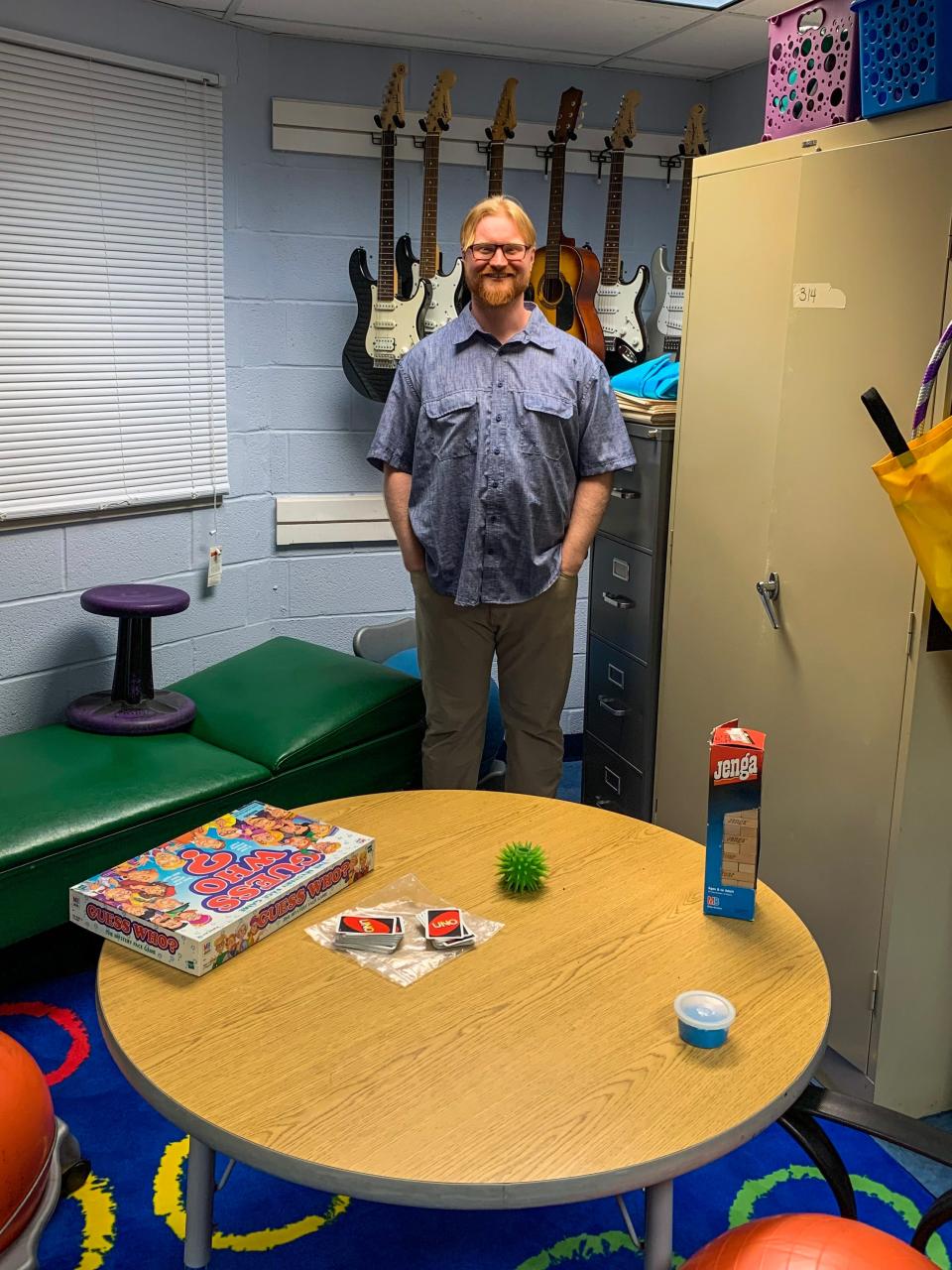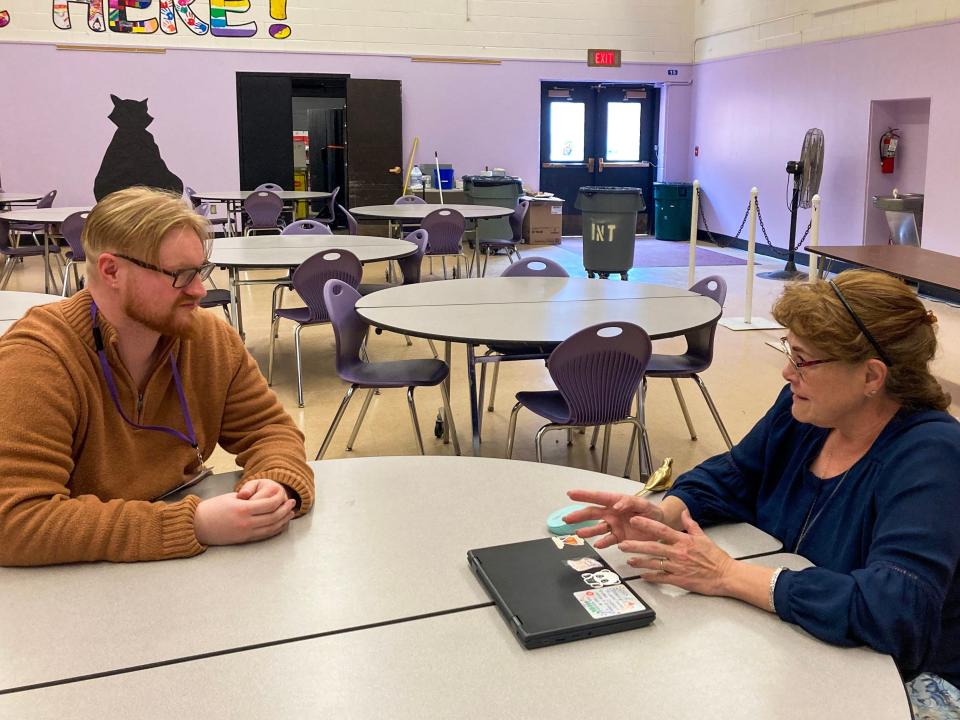US kids face mental health crisis amid school psychologist shortage. Can new federal money help?
SODUS, N.Y. – Daniel Bennett’s office at Sodus Intermediate School is a haven for kids in crisis.
When fourth, fifth or sixth graders here are fed up, ready to fight, or exhausting their teacher with their unfocused energy, they can visit Bennett’s office to jump on the mini trampoline, bounce on the balance ball chairs, or strum out their frustration on one of the guitars that hang on one wall.
This spring morning, a boy came in crying, complaining he’d been treated unfairly during a game in gym class. He told Bennett he didn’t understand the game’s rules and was punished for breaking them.
Bennett, a doctoral student at Roberts Wesleyan College here on a yearlong internship, helps each student identify their feelings, and validates them. While the student calms down, they might play a board game, shoot darts or mess with fidget toys.
On this day, though, the boy wasn’t interested in toys or games. He just wanted to talk – and be listened to.
“Sometimes you need to sit and be quiet,” Bennett said later.
Too few counselors as kids' mental health needs grow
Besides Bennett, Sodus Intermediate has two licensed psychologists on staff. But one functions as a school counselor, responsible for academic advising in addition to mental health counseling. Even with Bennett on board, it can be hard to meet the needs of all the kids and teachers in this low-income, rural district – especially since the pandemic.
“There’s a lot of trauma, and there are only so many hours in a day to meet with kids,” Bennett said.
Rates of anxiety and depression among youth and adolescents have reached record highs across the country, with the surgeon general calling kids’ declining mental health the “defining public health crisis of our time.” Yet, nationwide, there was just one school psychologist for every 1,127 K-12 students in 2020-21. The shortages of school social workers and counselors are just as bad.

These deficits are due both to a lack of funding and a lack of providers. Some schools can’t afford to hire more providers, while others struggle to find qualified providers because colleges aren’t producing enough of them, and low pay pushes some would-be school counselors into private practice or other specialties.
Now, spurred by an influx of federal funds, schools and colleges are undertaking an unprecedented effort to recruit and retain more school mental health providers. Districts are offering stipends to grad student interns and providing mentors to new hires. Colleges are creating new programs to introduce high schoolers to school mental-health careers, building online communities for isolated rural providers and launching virtual graduate degrees to attract busy professionals and far-flung students.
Bennett’s position at Sodus Intermediate, a 45-minute drive from Rochester, is funded through one of a pair of federal grant programs that received a huge funding increase in the Bipartisan Safer Communities Act, passed last year in response to the May 2022 mass shooting at Robb Elementary, in Uvalde, Texas.
What happened in a year? Mental health, safety investments promised after Uvalde shooting show little headway
Since December, the U.S. Department of Education has awarded $286 million to 264 grantees in nearly every state to boost the training and hiring of school mental health professionals, particularly those from marginalized racial and ethnic backgrounds. The agency estimates that the infusion of cash will prepare more than 14,000 new providers.
Schools also spent an estimated $2 billion in federal pandemic recovery dollars to hire mental health professionals – an investment that helped increase the number of social workers by nearly 50%, and the number of school counselors and psychologists by 10%, according to the Education Department. President Joe Biden has set a goal of doubling the number of school-based mental health professionals.
“Trying to enter a field that makes you work for free for two years is impossible for some of our economically disadvantaged populations.”
Andria Amador, senior director of behavioral health services, Boston Public Schools
Bennett, the son of a school psychologist, said he feels drawn to the mental health field. But with one week remaining on his internship, he is still considering whether he’ll pursue a job in a school or in another setting.
“I’m open to seeing where the wind takes me,” he said.
Rural settings, low pay work against hiring school counselors
At lunchtime, Bennett hurries to the cafeteria to collect four rambunctious fifth grade boys for a skills group. Trays in hand, they race down the hall to Bennett’s office, scarfing up tater tots with their mouths.
The topic today is listening. The group starts with a silly song about being a “whole body listener,” drawing or coloring what they hear or think as they listen.
When the song ends, Bennett asks the students to describe their drawings and then share which classmate did the best job of listening while they spoke.
Josh holds up a picture of a guy playing with his ears, and Bennett asks what it represents.
“Hear teachers talk,” Josh answers.
“And who was the best listener?” Bennett asks.
“You,” Josh says. “Your eyes were on me, and you weren’t tapping the floor.”
Matt, who is dressed head-to-toe in Spider-Man attire, jumps in to defend himself. “The way I focus and calm down is by fidgeting,” he explains.
The phone rings, interrupting the sharing. It’s a teacher who wants to know if she can send a student who is in crisis. Bennett says he has five minutes after the skills group ends – after that he’s got to meet with another teacher.
“I love the community in schools — getting to eat lunch with colleagues, being surrounded by youngsters. But it would be very hard to support myself on the entry level salaries in this setting.”
Daniel Bennett, a doctoral student on a yearlong internship as a school counselor
When the session ends, Bennett returns the boys to their classrooms, and picks up the student who the teacher had called about. As they walk to Bennett’s office, the student says that he accidentally squirted water on his teacher’s phone, and she smacked him on the arm. “Now I’m mad all day,” the student says.
They head back to Bennett’s office, where the student calms down by strumming on a guitar. Bennett asks the boy what type of music is his favorite (country, he says), and tells him he used to play bass in a high school band; he had hair down to his shoulders.
“Let it wash off you like water,” Bennett says, encouragingly.
Rural districts tend to have a harder time recruiting school psychologists, because there are fewer training programs near rural districts. But even if more graduates were willing to relocate, the number of students graduating from programs in psychology, counseling and social work isn’t keeping pace with districts’ growing demand for mental health services, said Kelly Vaillancourt Strobach, director of policy and advocacy for the National Association of School Psychologists.
Another reason schools struggle to recruit and retain mental health providers is in part because of the low pay. (The average salary for a school psychologist is about $88,000; for clinical and counseling psychologists it’s $103,000; industrial psychologists, who work in businesses and organizations, earn an average of $145,000.)
In addition, schools often ask providers, especially school counselors, to take on administrative duties, like test proctoring and cafeteria and bathroom monitoring. That “pulls them away from the work they’re passionate about” and contributes to counselor turnover, said Eric Sparks, deputy executive director of the American School Counselor Association.
New York is doing better than some states in hiring and retaining school psychologists: Its ratio is 1:662. But before the Sodus Central School District and five other districts received the federal grant, in 2019, only five of 19 schools had a social worker on staff, said Hennessey Lustica, who oversees the grant.
With the help of the federal dollars, the districts have been able to hire roughly 20 interns in psychology, social work and counseling each year for the past four years. They pay them a stipend and mileage – a rarity in graduate internships – and place them in interdisciplinary groups that meet twice a month to review cases and share ideas on how to approach them.
A growing crisis: US schools failing in fight against youth mental health crisis, new report card finds
Experiments to hire, retain school counselors abound
So far, that strategy seems to be paying off in terms of persuading interns to return to schools when they graduate: More than three-quarters of former interns have been hired into high-need districts in New York, Lustica said.
Boston Public Schools is also using stipends to attract potential job candidates – particularly those that match the district’s demographics. Though Boston has had more success recruiting than many districts, it’s struggled to hire bilingual providers and those from underrepresented racial and ethnic backgrounds, said Andria Amador, the district’s senior director of behavioral health services.
“Trying to enter a field that makes you work for free for two years is impossible for some of our economically disadvantaged populations,” Amador said.
Other recipients of the federal grants are trying different approaches. In Texas, a “grow your own” program is paying teachers to pursue degrees in counseling; in Wisconsin, a new virtual master’s program is reaching Native students on reservations located hours from a college campus.
Nevada has started recruiting in high school, and in Virginia, educators are tackling high turnover among isolated rural providers through an online professional development program.
Back at Sodus Intermediate, Bennett is running late for his meeting with Jennifer Gibson, a longtime special education teacher with a challenging class. But when he arrives in the cafeteria, Gibson isn’t there. She shows up a minute later, saying she got caught up disciplining kids.

Bennett and Gibson meet fairly often to discuss strategies for dealing with difficult student behaviors, he says. Their sessions typically start with venting, and this day is no exception.
Gibson tells Bennett she’s relieved that a particularly disruptive student has left her class, and frustrated that he was put there to begin with.
Then, they move on to problem-solving. Bennett asks Gibson what she was disciplining students for.
“Just kids being sassy,” she says. One student, in particular, wouldn’t settle down after lunch.
“What do you think was the reason?” Bennett asks.
Gibson speculates that it might have been the change in seasons – the warmer weather always makes transitions harder.
Then Gibson remembers that the student hadn’t eaten; he’d hit a kid on the bus and spent the lunch period in suspension. She’d forgotten to give him his usual “brain break” after lunch, too.
“So that’s my fault,” she says, guiltily.
“There’s no blaming or shaming here,” Bennett reminds her. They discuss how Gibson can ensure the student gets his energy out before returning to class after lunch.
At one point in the meeting, Gibson asks Bennett when his last day is. Next Thursday, he tells her.
“That’s awful,” she says. “I wish we could pay to hire you.”
But Bennett, who starts a new internship at a healthcare organization in Pennsylvania later this month, now doubts he’ll settle in a school when he finishes his doctoral program next spring. With $150,000 in student debt, he’ll need to find something a little more lucrative.
“I love the community in schools – getting to eat lunch with colleagues, being surrounded by youngsters,” Bennett wrote in an email on the last day of his internship. “But it would be very hard to support myself on the entry level salaries in this setting.”
This story about federal grants for counseling was produced by The Hechinger Report, a nonprofit, independent news organization focused on inequality and innovation in education. Sign up for the Hechinger newsletter.
This article originally appeared on USA TODAY: School psychologists are scarce as schools face mental health crisis.

